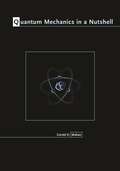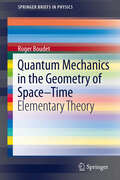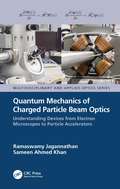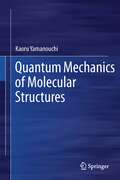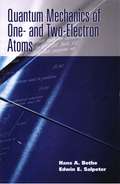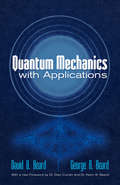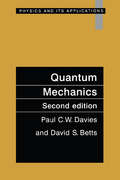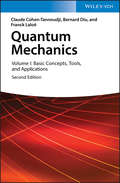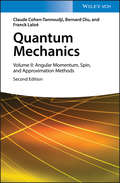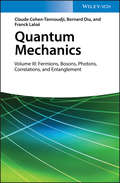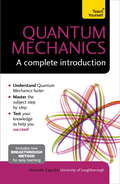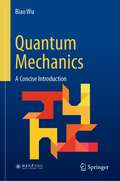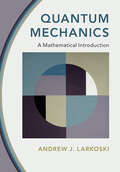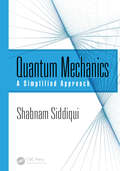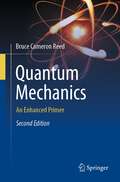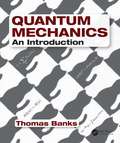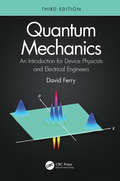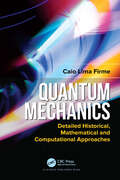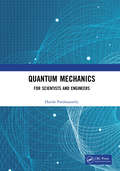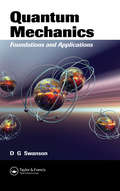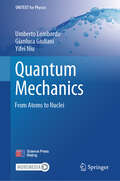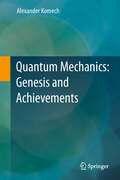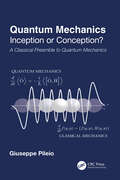- Table View
- List View
Quantum Mechanics in a Nutshell (In a Nutshell #5)
by Gerald D. MahanCovering the fundamentals as well as many special topics of current interest, this is the most concise, up-to-date, and accessible graduate-level textbook on quantum mechanics available. Written by Gerald Mahan, a distinguished research physicist and author of an acclaimed textbook on many-particle physics, Quantum Mechanics in a Nutshell is the distillation of many years' teaching experience. Emphasizing the use of quantum mechanics to describe actual quantum systems such as atoms and solids, and rich with interesting applications, the book proceeds from solving for the properties of a single particle in potential; to solving for two particles (the helium atom); to addressing many-particle systems. Applications include electron gas, magnetism, and Bose-Einstein Condensation; examples are carefully chosen and worked; and each chapter has numerous homework problems, many of them original. Quantum Mechanics in a Nutshell expertly addresses traditional and modern topics, including perturbation theory, WKBJ, variational methods, angular momentum, the Dirac equation, many-particle wave functions, Casimir Force, and Bell's Theorem. And it treats many topics--such as the interactions between photons and electrons, scattering theory, and density functional theory--in exceptional depth. A valuable addition to the teaching literature, Quantum Mechanics in a Nutshell is ideally suited for a two-semester course. The most concise, up-to-date, and accessible graduate textbook on the subject Contains the ideal amount of material for a two-semester course Focuses on the description of actual quantum systems, including a range of applications Covers traditional topics, as well as those at the frontiers of research Treats in unprecedented detail topics such as photon-electron interaction, scattering theory, and density functional theory Includes numerous homework problems at the end of each chapter
Quantum Mechanics in the Geometry of Space-Time
by Roger BoudetThis book continues the fundamental work of Arnold Sommerfeld and David Hestenes formulating theoretical physics in terms of Minkowski space-time geometry. We see how the standard matrix version of the Dirac equation can be reformulated in terms of a real space-time algebra, thus revealing a geometric meaning for the "number i" in quantum mechanics. Next, it is examined in some detail how electroweak theory can be integrated into the Dirac theory and this way interpreted in terms of space-time geometry. Finally, some implications for quantum electrodynamics are considered. The presentation of real quantum electromagnetism is expressed in an addendum. The book covers both the use of the complex and the real languages and allows the reader acquainted with the first language to make a step by step translation to the second one.
Quantum Mechanics of Charged Particle Beam Optics: Understanding Devices from Electron Microscopes to Particle Accelerators (Multidisciplinary and Applied Optics)
by Ramaswamy Jagannathan Sameen Ahmed KhanClassical Charged Particle Beam Optics used in the design and operation of all present-day charged particle beam devices, from low energy electron microscopes to high energy particle accelerators, is entirely based on classical mechanics. A question of curiosity is: How is classical charged particle beam optics so successful in practice though the particles of the beam, like electrons, are quantum mechanical? Quantum Mechanics of Charged Particle Beam Optics answers this question with a comprehensive formulation of ‘Quantum Charged Particle Beam Optics’ applicable to any charged particle beam device.
Quantum Mechanics of Molecular Structures
by Kaoru YamanouchiAt a level accessible to advanced undergraduates, this textbook explains the fundamental role of quantum mechanics in determining the structure, dynamics, and other properties of molecules. Readers will come to understand the quantum-mechanical basis for harmonic oscillators, angular momenta and scattering processes. Exercises are provided to help readers deepen their grasp of the essential phenomena.
Quantum Mechanics of One- and Two-Electron Atoms (Dover Books on Physics)
by Edwin E. Salpeter Hans A. BetheThis classic of modern physics includes a vast array of approximation methods, mathematical tricks, and physical pictures that are also useful in the application of quantum mechanics to other fields. Students and professionals will find it an essential reference for calculations pertaining to hydrogen-like and helium-like atoms and their comparison with experimental results. In-depth explorations of the Dirac theory of the electron and of radiative effects include brief accounts of relevant experiments. The specific application of general field-theoretic results to atomic systems also receives a thorough examination. Author Hans A. Bethe (1906-2005), Professor of Physics at Cornell University, won the Nobel Prize in Physics in 1967. Co-author Edwin E. Salpeter is James Gilbert White Distinguished Professor of the Physical Sciences at Cornell University.
Quantum Mechanics with Applications
by Prof. David B Beard Kevin B Beard Prof. George B BeardThis introductory text emphasizes Feynman's development of path integrals and its application to wave theory for particles. Suitable for undergraduate and graduate students of physics, the well-written, clear, and rigorous text was written by two of the nation's leading authorities on quantum physics. A solid foundation in quantum mechanics and atomic physics is assumed.Early chapters provide background in the mathematical treatment and particular properties of ordinary wave motion that also apply to particle motion. The close relation of quantum theory to physical optics is stressed. Subsequent sections emphasize the physical consequences of a wave theory of material properties, and they offer extensive applications in atomic physics, nuclear physics, solid state physics, and diatomic molecules. Four helpful Appendixes supplement the text.
Quantum Mechanics with Basic Field Theory
by Bipin R. DesaiStudents and instructors alike will find this organized and detailed approach to quantum mechanics ideal for a two-semester graduate course on the subject. This textbook covers, step-by-step, important topics in quantum mechanics, from traditional subjects like bound states, perturbation theory and scattering, to more current topics such as coherent states, quantum Hall effect, spontaneous symmetry breaking, superconductivity, and basic quantum electrodynamics with radiative corrections. The large number of diverse topics are covered in concise, highly focused chapters, and are explained in simple but mathematically rigorous ways. Derivations of results and formulae are carried out from beginning to end, without leaving students to complete them. With over 200 exercises to aid understanding of the subject, this textbook provides a thorough grounding for students planning to enter research in physics. Several exercises are solved in the text, and password-protected solutions for remaining exercises are available to instructors at www. cambridge. org/9780521877602.
Quantum Mechanics, Second edition (Physics and its Applications)
by Paul C.W. DaviesQuantum mechanics is the key to modern physics and chemistry, yet it is notoriously difficult to understand. This book is designed to overcome that obstacle. Clear and concise, it provides an easily readable introduction intended for science undergraduates with no previous knowledge of quantum theory, leading them through to the advanced topics usually encountered at the final year level.Although the subject matter is standard, novel techniques have been employed that considerably simplify the technical presentation. The authors use their extensive experience of teaching and popularizing science to explain the many difficult, abstract points of the subject in easily comprehensible language. Helpful examples and thorough sets of exercises are also given to enable students to master the subject.
Quantum Mechanics, Volume 1: Basic Concepts, Tools, and Applications
by Claude Cohen-Tannoudji Franck Laloë Bernard DiuThis new edition of the unrivalled textbook introduces the fundamental concepts of quantum mechanics such as waves, particles and probability before explaining the postulates of quantum mechanics in detail. In the proven didactic manner, the textbook then covers the classical scope of introductory quantum mechanics, namely simple two-level systems, the one-dimensional harmonic oscillator, the quantized angular momentum and particles in a central potential. The entire book has been revised to take into account new developments in quantum mechanics curricula. The textbook retains its typical style also in the new edition: it explains the fundamental concepts in chapters which are elaborated in accompanying complements that provide more detailed discussions, examples and applications. * The quantum mechanics classic in a new edition: written by 1997 Nobel laureate Claude Cohen-Tannoudji and his colleagues Bernard Diu and Franck Laloë * As easily comprehensible as possible: all steps of the physical background and its mathematical representation are spelled out explicitly * Comprehensive: in addition to the fundamentals themselves, the book contains more than 350 worked examples plus exercises Claude Cohen-Tannoudji was a researcher at the Kastler-Brossel laboratory of the Ecole Normale Supérieure in Paris where he also studied and received his PhD in 1962. In 1973 he became Professor of atomic and molecular physics at the Collège des France. His main research interests were optical pumping, quantum optics and atom-photon interactions. In 1997, Claude Cohen-Tannoudji, together with Steven Chu and William D. Phillips, was awarded the Nobel Prize in Physics for his research on laser cooling and trapping of neutral atoms. Bernard Diu was Professor at the Denis Diderot University (Paris VII). He was engaged in research at the Laboratory of Theoretical Physics and High Energy where his focus was on strong interactions physics and statistical mechanics. Franck Laloë was a researcher at the Kastler-Brossel laboratory of the Ecole Normale Supérieure in Paris. His first assignment was with the University of Paris VI before he was appointed to the CNRS, the French National Research Center. His research was focused on optical pumping, statistical mechanics of quantum gases, musical acoustics and the foundations of quantum mechanics.
Quantum Mechanics, Volume 2: Angular Momentum, Spin, and Approximation Methods (Quantum Mechanics Ser. #Vol. 2)
by Claude Cohen-Tannoudji Franck Laloë Bernard DiuThis new edition of the unrivalled textbook introduces concepts such as the quantum theory of scattering by a potential, special and general cases of adding angular momenta, time-independent and time-dependent perturbation theory, and systems of identical particles. The entire book has been revised to take into account new developments in quantum mechanics curricula. The textbook retains its typical style also in the new edition: it explains the fundamental concepts in chapters which are elaborated in accompanying complements that provide more detailed discussions, examples and applications. * The quantum mechanics classic in a new edition: written by 1997 Nobel laureate Claude Cohen-Tannoudji and his colleagues Bernard Diu and Franck Laloë * As easily comprehensible as possible: all steps of the physical background and its mathematical representation are spelled out explicitly * Comprehensive: in addition to the fundamentals themselves, the book contains more than 170 worked examples plus exercises Claude Cohen-Tannoudji was a researcher at the Kastler-Brossel laboratory of the Ecole Normale Supérieure in Paris where he also studied and received his PhD in 1962. In 1973 he became Professor of atomic and molecular physics at the Collège des France. His main research interests were optical pumping, quantum optics and atom-photon interactions. In 1997, Claude Cohen-Tannoudji, together with Steven Chu and William D. Phillips, was awarded the Nobel Prize in Physics for his research on laser cooling and trapping of neutral atoms. Bernard Diu was Professor at the Denis Diderot University (Paris VII). He was engaged in research at the Laboratory of Theoretical Physics and High Energy where his focus was on strong interactions physics and statistical mechanics. Franck Laloë was a researcher at the Kastler-Brossel laboratory of the Ecole Normale Supérieure in Paris. His first assignment was with the University of Paris VI before he was appointed to the CNRS, the French National Research Center. His research was focused on optical pumping, statistical mechanics of quantum gases, musical acoustics and the foundations of quantum mechanics.
Quantum Mechanics, Volume 3: Fermions, Bosons, Photons, Correlations, and Entanglement
by Claude Cohen-Tannoudji Franck Laloë Bernard DiuThis new, third volume of Cohen-Tannoudji's groundbreaking textbook covers advanced topics of quantum mechanics such as uncorrelated and correlated identical particles, the quantum theory of the electromagnetic field, absorption, emission and scattering of photons by atoms, and quantum entanglement. Written in a didactically unrivalled manner, the textbook explains the fundamental concepts in seven chapters which are elaborated in accompanying complements that provide more detailed discussions, examples and applications. * Completing the success story: the third and final volume of the quantum mechanics textbook written by 1997 Nobel laureate Claude Cohen-Tannoudji and his colleagues Bernard Diu and Franck Laloë * As easily comprehensible as possible: all steps of the physical background and its mathematical representation are spelled out explicitly * Comprehensive: in addition to the fundamentals themselves, the books comes with a wealth of elaborately explained examples and applications Claude Cohen-Tannoudji was a researcher at the Kastler-Brossel laboratory of the Ecole Normale Supérieure in Paris where he also studied and received his PhD in 1962. In 1973 he became Professor of atomic and molecular physics at the Collège des France. His main research interests were optical pumping, quantum optics and atom-photon interactions. In 1997, Claude Cohen-Tannoudji, together with Steven Chu and William D. Phillips, was awarded the Nobel Prize in Physics for his research on laser cooling and trapping of neutral atoms. Bernard Diu was Professor at the Denis Diderot University (Paris VII). He was engaged in research at the Laboratory of Theoretical Physics and High Energy where his focus was on strong interactions physics and statistical mechanics. Franck Laloë was a researcher at the Kastler-Brossel laboratory of the Ecole Normale Supérieure in Paris. His first assignment was with the University of Paris VI before he was appointed to the CNRS, the French National Research Center. His research was focused on optical pumping, statistical mechanics of quantum gases, musical acoustics and the foundations of quantum mechanics.
Quantum Mechanics: A Complete Introduction: Teach Yourself
by Alexandre ZagoskinWritten by Dr Alexandre Zagoskin, who is a Reader at Loughborough University, Quantum Mechanics: A Complete Introduction is designed to give you everything you need to succeed, all in one place. It covers the key areas that students are expected to be confident in, outlining the basics in clear jargon-free English, and then providing added-value features like summaries of key ideas, and even lists of questions you might be asked in your exam. The book uses a structure that is designed to make quantum physics as accessible as possible - by starting with its similarities to Newtonian physics, rather than the rather startling differences.
Quantum Mechanics: A Concise Introduction
by Biao WuThis textbook highlights a concise introduction to quantum mechanics in a readable and serious manner. Being readable, the book intends to present the beauty and magic of quantum mechanics to the mass public. Being serious, the book uses mathematics to describe the most profound results in quantum mechanics. To balance the two, the book assumes that the readers are familiar with high-school mathematics and instructs the least possible advanced mathematics necessary for the understanding of quantum mechanics.The book first covers the history of quantum mechanics and then introduces the magical quantum world, including quantum states living in Hilbert space, indistinguishable particles,linear superposition, Heisenberg's uncertainty relations, quantum entanglement, Bell's inequality, quantum energy levels, Schrödinger’s cat and many-worlds theory, etc. To compare with classic physics, the book also covers the classic mechanics before introducing quantum mechanics. At last, the book briefly covers quantum computing and quantum communications. Besides readers of other majors, the book is also a good reference for students in physics. It helps physics students to develop a solid understanding of the basics of quantum mechanics, preventing them from getting lost in solving the Schrödinger equation. The book also discusses quantum entanglement and quantum information which traditional quantum mechanics textbooks do not cover. The Foreword is written by Frank Wilczek, Nobel Laureate in physics, 2004.This book is a translation of an original German edition. The translation was done with the help of artificial intelligence (machine translation by the service DeepL.com). A subsequent human revision was done primarily in terms of content, so that the book will read stylistically differently from a conventional translation.
Quantum Mechanics: A Graduate Course
by Horatiu NastaseWritten for a two-semester graduate course in Quantum Mechanics, this comprehensive text helps develop the tools and formalism of Quantum Mechanics and its applications to physical systems. It suits students who have taken some introductory Quantum Mechanics and Modern Physics courses at undergraduate level, but it is self-contained and does not assume any specific background knowledge beyond appropriate fluency in mathematics. The text takes a modern logical approach rather than a historical one and it covers standard material, such as the hydrogen atom and the harmonic oscillator, the WKB approximations and Bohr-Sommerfeld quantization. Important modern topics and examples are also described, including Berry phase, quantum information, complexity and chaos, decoherence and thermalization, nonstandard statistics, as well as more advanced material such as path integrals, scattering theory, multiparticles and Fock space. Readers will gain a broad overview of Quantum Mechanics, as solid preparation for further study or research.
Quantum Mechanics: A Mathematical Introduction
by Andrew J. LarkoskiThis original and innovative textbook takes the unique perspective of introducing and solving problems in quantum mechanics using linear algebra methods, to equip readers with a deeper and more practical understanding of this fundamental pillar of contemporary physics. Extensive motivation for the properties of quantum mechanics, Hilbert space, and the Schrödinger equation is provided through analysis of the derivative, while standard topics like the harmonic oscillator, rotations, and the hydrogen atom are covered from within the context of operator methods. Advanced topics forming the basis of modern physics research are also included, such as the density matrix, entropy, and measures of entanglement. Written for an undergraduate audience, this book offers a unique and mathematically self-contained treatment of this hugely important topic. Students are guided gently through the text by the author's engaging writing style, with an extensive glossary provided for reference and numerous homework problems to expand and develop key concepts. Online resources for instructors include a fully worked solutions manual and lecture slides.
Quantum Mechanics: A Simplified Approach
by Shabnam SiddiquiQuantum mechanics is one of the most challenging subjects to learn. It is challenging because quantum phenomenon is counterintuitive, and the mathematics used to explain such a phenomenon is very abstract, and difficult to grasp. This textbook is an attempt to overcome these challenges. Every chapter presents quantum ideas step- by- step in a structured way with a comparison between quantum and classical concepts. It provides a clear distinction between classical and quantum logic. Conceptual questions are provided after every important section so that the reader can test their understanding at every step. Such an approach aids in preventing misconceptions. Problem solving is not restricted to solving differential equations and integration. But it requires to systematically and creatively analyze a problem, to apply the new and powerful concepts for finding a solution and to understand the physical meaning of the solution. The tutorials on special topics are an effort to teach problem solving by actively engaging the reader in a thinking process, to apply the concepts and to understand the physical meaning of the solution. The simulations are provided for some of the topics. The simulations aid in the visualization of the quantum phenomenon, and for meaningful understanding of the mathematics. This approach may lead to development of "quantum mechanical intuition "as well as learning mathematical techniques for problem solving. Most importantly, the book is not flooded with numerous topics that makes the reader confused and distracted, rather the most important topics are discussed at a deeper level. The understanding of quantum mechanics is incomplete without understanding the early ideas and experiments that lead to the development of the quantum theory. Thus, the first two chapters of the book are dedicated to such topics. The key features of this book are: A simplified, structured, and step-by-step introduction to quantum mechanics. The simplification is attained through use of two-level system, step- by- step discussion of important topics in a simplified language at a deeper level, analogies, and visualization using illustrations and simulations A systematic arrangement of topics, and numerous worked- out examples. The presentation of the structure in the mathematical formalism of quantum mechanics provides clarity in understanding complicated and abstract mathematics. It also helps to understand the distinction between the quantum mechanical and classical approaches Conceptual questions at the end of every important section. The conceptual questions can be used in a classroom as a point of discussion between an instructor and students Tutorials on special topics. Simulations on special topics aid in the visualization of the physical phenomenon, and demonstration of the application of mathematics An in-depth discussion of the wave-particle duality, measurement problem, and their philosophical implications in Chapter 2 provides an understanding of the broader meaning of quantum mechanics
Quantum Mechanics: An Enhanced Primer
by Bruce Cameron ReedQuantum mechanics is one of the most fascinating elements of the physics curriculum, but its conceptual nuances and mathematical complexity can be daunting for beginning students. This user-friendly text is designed for a one-semester course which bridges the gap between sophomore-level treatments and advanced undergraduate/lower-graduate courses. Qualitative explanations and descriptions of historical background are combined with detailed mathematical analyses to help students establish a firm foundation for further study. Classical problems such potential wells, barrier penetration, alpha decay, the harmonic oscillator, and the hydrogen atom are examined in detail, and formalisms and techniques such as operators, expectation values, commutators, perturbation theory, numerical solutions, and the variational theorem are also covered. Particular emphasis is placed on providing numerous worked examples and exercises.
Quantum Mechanics: An Introduction
by Thomas Banks"pedagogical and accessible"—Nathan Seiberg, Professor, Institute for Advanced Study, Princeton, New Jersey "an excellent book"—Andreas Karch, Professor, University of Washington "provides remarkable insights into technical aspects of the subject, but also into the most basic conceptual questions which trouble both new students and more mature researchers"—Michael Dine, Professor, University of California, Santa Cruz This authoritative, advanced introduction provides a complete, modern perspective on quantum mechanics. It clarifies many common misconceptions regarding wave/particle duality and the correct interpretation of measurements. The author develops the text from the ground up, starting from the fundamentals and presenting information at an elementary level, avoiding unnecessarily detailed and complex derivations in favor of simple, clear explanations. He begins in the simplest context of a two-state system and shows why quantum mechanics is inevitable, and what its relationship is to classical mechanics. He also outlines the decoherence approach to interpreting quantum mechanics. Distinguishing features: Provides a thorough grounding in the principles and practice of quantum mechanics, including a core understanding of the behavior of atoms, molecules, solids, and light. Utilizes easy-to-follow examples and analogies to illustrate important concepts. Helps develop an intuitive sense for the field, by guiding the reader to understand how the correct formulas reduce to the non-relativistic ones. Includes numerous worked examples and problems for each chapter. Thomas Banks is a theoretical physicist at University of California, Santa Cruz and a professor at Rutgers University. He earned his PhD in physics from the Massachusetts Institute of Technology, and has been a visiting scholar at the Institute for Advanced Study in Princeton, New Jersey. Professor Banks is the recipient of a Guggenheim Fellowship and is an elected member of the American Academy of Arts and Sciences.
Quantum Mechanics: An Introduction for Device Physicists and Electrical Engineers
by David FerryQuantum Mechanics: An Introduction for Device Physicists and Electrical Engineers, Third Edition provides a complete course in quantum mechanics for students of semiconductor device physics and electrical engineering. It provides the necessary background to quantum theory for those starting work on micro- and nanoelectronic structures and is particularly useful for those beginning work with modern semiconductors devices, lasers, and qubits. This book was developed from a course the author has taught for many years with a style and order of presentation of material specifically designed for this audience. It introduces the main concepts of quantum mechanics which are important in everyday solid-state physics and electronics. Each topic includes examples which have been carefully chosen to draw upon relevant experimental research. It also includes problems with solutions to test understanding of theory. Full updated throughout, the third edition contains the latest developments, experiments, and device concepts, in addition to three fully revised chapters on operators and expectations and spin angular momentum, it contains completely new material on superconducting devices and approaches to quantum computing.
Quantum Mechanics: Detailed Historical, Mathematical and Computational Approaches
by Caio Lima FirmeMain features:i) A different approach for teaching Quantum Mechanics encompassing old quantum mechanics, matrix mechanics and wave mechanics in a historical perspective which helps to consolidate most important concepts of Quantum Mechanics;ii) Original information from the most important papers of Quantum Mechanics;iii) Derivation of all important equations of Quantum Mechanics, for example, Heisenberg’s uncertainty principle, de Broglie’s wave-particle duality, Schrödinger’s wave equation, etc., showing their interrelations through Dirac’s equations and other applications of matrix and wave mechanics;iv) Comprehensive mathematical support for the understanding of Quantum Mechanics; derivation of all equations make reading easier;v) The illustrations of the book cover examples, exercises and do-it-yourself activities;vi) Fundamentals of Fortran and numerical calculation along with the source codes for numerical solutions of several mathematical and quantum problems. All source codes are in the author’s site: (https://www.fortrancodes.com/);vii) Chapters devoted to linear algebra and differential equations applied to quantum mechanics and their numerical solutions;viii) Complete solution for the one-electron and two-electron problems using Schrödinger’s time independent equation along with their source codes.
Quantum Mechanics: For Scientists and Engineers
by Harish ParthasarathyThis book covers the entire span of quantum mechanics whose developments have taken place during the early part of the twentieth century up till the present day. We start with the Rutherford-Bohr model of the atom followed by Schrodinger's wave mechanics with its application to the solution of calculating the energy spectrum of a particle in a box, the harmonic oscillator and finally the hydrogen atom. Heisenberg's matrix mechanics and its duality with Schrodinger's wave mechanics, quantum mechanics in the interaction picture. Dirac's relativistic theory of the electron exhibiting the spin of the electron as a relativistic effect when it interacts with an external electromagnetic field. Feynman's path integral approach to non-relativistic quantum mechanics with is a marvellous intuitive interpretation as a sum over paths and how classical mechanics is obtained from its limit as Planck' constant tends to zero, methods for computing the spectra of the Dirac Hamiltonian in a radial potential, quantum field theory as developed by Feynman, Schwinger, Tomonaga and Dyson for describing the interaction between electrons, positrons, and photons via propagators using both the operator theoretic expansions and Feynman's path integral. We also introduce time independent and time dependent perturbation theory in quantum mechanics with applications to quantum gate design for quantum computers forming a major part of the research conducted by the author's research group, Quantum noise introduced into the Schrodinger and Dirac's equation based on the Hudson-Parthasarathy quantum stochastic calculus in Boson Fock space, scattering theory and wave operators with applications to quantum gate design, some aspects of second quantization like the interpretation of Boson Fock space in terms of harmonic oscillator algebras and the BCS theory of superconductivity, Wigner-Mackey-Frobenius theory of induced representations of a group with applications to Wigner's theory of particle classification, Dirac's equation in a gravitational field and Yang-Mills non-Abelian gauge theories with application to the construction of unified quantum field theories and finally, the more recent theory of super-symmetry which is a Boson-Fermion unification theory. We have discussed the statistics of Boson's, Fermions and Maxwell-Boltzmann based on entropy maximization. The book is written in problem-solution format and it would be of use to physicists and engineers interested respectively in developing unified field theories and in the design of quantum gates. Note: T&F does not sell or distribute the Hardback in India, Pakistan, Nepal, Bhutan, Bangladesh and Sri Lanka.
Quantum Mechanics: Foundations and Applications
by Donald Gary SwansonProgressing from the fundamentals of quantum mechanics (QM) to more complicated topics, Quantum Mechanics: Foundations and Applications provides advanced undergraduate and graduate students with a comprehensive examination of many applications that pertain to modern physics and engineering.Based on courses taught by the author, this textboo
Quantum Mechanics: From Atoms to Nuclei (UNITEXT for Physics)
by Umberto Lombardo Gianluca Giuliani Yifei NiuThis book is intended to provide a self-contained introduction to the principles of Quantum Mechanics, based on the analysis of measurement processes of microscopic systems and the introduction of the physical observables as generators of symmetry transformations. After standard training arguments the applications are mainly focused on atomic and nuclear phenomena, as they occur on a quite different space-time scale. Thus, the text flows from the simplest systems, i.e. proton-electron in the hydrogen atom and proton-neutron in the Deuteron nucleus, to the complex many- body systems, i.e. stable states of atoms and nuclei of the periodic table, and finally to infinite many-body systems, including atomic and nuclear fluids. A digression is made on the application to astrophysical compact systems. The textbook is suitable for upper undergraduate students and graduate students in physics and related majors. Additional questions and answers via app: Download the Springer Nature Flashcards app free of charge and use exclusive additional material to test your knowledge.
Quantum Mechanics: Genesis and Achievements
by Alexander KomechThe focus of the present work is nonrelativistic and relativistic quantum mechanics with standard applications to the hydrogen atom. The author has aimed at presenting quantum mechanics in a comprehensive yet accessible for mathematicians and other non-physicists. The genesis of quantum mechanics, its applications to basic quantum phenomena, and detailed explanations of the corresponding mathematical methods are presented. The exposition is formalized (whenever possible) on the basis of the coupled Schroedinger, Dirac and Maxwell equations. Aimed at upper graduate and graduate students in mathematical and physical science studies.
Quantum Mechanics: Inception or Conception? A Classical Preamble to Quantum Mechanics
by Giuseppe PileioEmbarking on a journey into the realm of quantum mechanics can be a daunting task for anyone. Its puzzling mathematics and bewildering predictions often leave individuals feeling confused and disheartened. But what if there was a different approach — one aimed to cultivate an understanding of quantum mechanics from its very foundations? This is the ambition of this book. Rather than treating quantum mechanics as an inception, the author takes a Socratic perspective, tracing the genesis of its key ideas back to the well-established roots of classical mechanics. The works of Lagrange, Hamilton, and Poisson become guiding lights, illuminating the path towards comprehension. Through a colloquial yet pedagogical narrative, the book delves into the elements of classical mechanics, building a solid framework of familiarity that paves the way for comprehending quantum mechanics.Designed as a companion for undergraduates undertaking quantum mechanics modules in physics or chemistry, this book serves as an invaluable support. It equips learners with the essential knowledge necessary to grasp the foundations of quantum mechanics. As such, it proves equally beneficial for MSc and PhD scholars, and post-doctoral researchers. Its colloquial tone captivates the curiosity of any reader eager to delve into the mysteries of this enthralling field.
